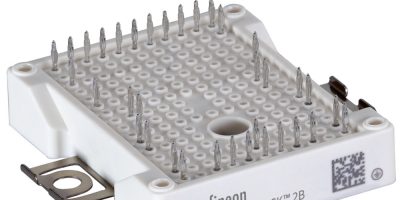Infineon Technologies has launched the automotive qualified EasyPack 2B EDT2, a flexible and scalable half-bridge power module. Depending on inverter conditions, this 750 V device can reach a maximum power of up to 50 kW and 230 A RMS. The module is optimised for inverter applications in hybrid and electric vehicles.
With the introduction of the EDT2 (electric drive train) technology in this package and full automotive qualification, Infineon is now expanding the application range of the module family to include traction inverters.
The key feature of the EDT2 technology is the higher efficiency at low-load conditions. An EDT2 chip helps ensure significantly lower losses than current products on the market, says Infineon, and outperforms Infineon’s previous chip generation by 20 per cent.
Plug-and-play simplifies integration and compared to the classic through-hole discrete packages, as well as the HybridPack 1, there Is no longer a need to solder pins.
Infineon’s PressFIT contact technology enables a reduction in mounting time and the compact package size means three EasyPack 2Bs need 30 per cent less surface area than a HybridPack 1.
The EasyPack 2B EDT2 is fully qualified to the AQG324 standard.
Over the past 10 years, Infineon has sold more than 50 million EasyPack module with various chip sets for a range of industrial and automotive applications.
The new EasyPack 2B EDT2 module FF300R08W2P2_B11A will be available starting in this month.
For more information go to http://www.infineon.com/easyinverter







